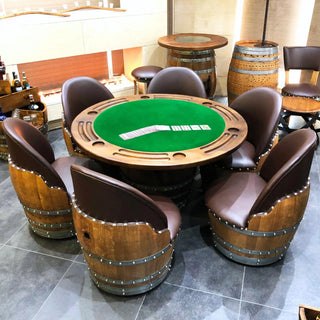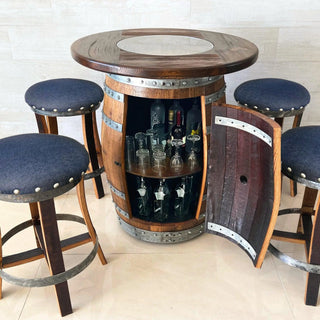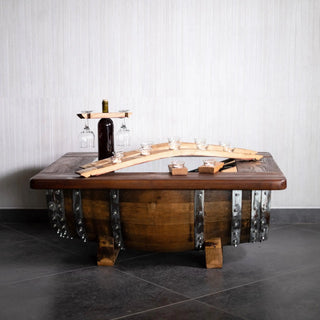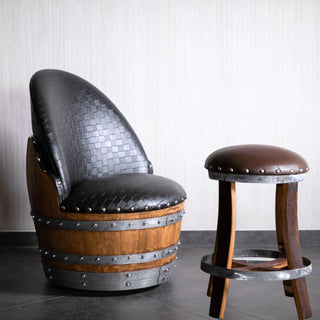The Ultimate Guide to Caring for Your Oak Barrel Tables
If you’ve ever brought home a real oak barrel table, you already know — it’s not just another piece of furniture. It’s a statement, a story, and maybe even a small piece of art. You can feel it the second you run your hand along the grain. It’s solid. Heavy. Real. The kind of thing you want to keep for years because it just gets better with time.
But here’s the truth: oak furniture doesn’t stay beautiful on its own. It needs a little love, a bit of attention — the same way a classic car or a good leather jacket does. The more you care for it, the richer and more alive it becomes.
I’ve had my fair share of barrel coffee tables and end tables over the years — one made from an old whiskey cask, another from a red wine barrel that still faintly smelled like Cabernet when it arrived. And every one of them has aged differently, developed new tones, and grown more beautiful with use.
So let’s talk about how to keep your oak barrel table looking its best — not with fancy products or strict rules, but with real, easy habits that keep your wood glowing, breathing, and proud.
Oak Has a Personality — Learn It
Caring for oak starts with understanding it. It’s not a delicate wood, but it is alive in its own way. Every table from Oak Wood Wine Barrels is built from reclaimed oak — meaning it’s already lived a full life aging wine or whiskey before it ever became furniture.
That means it’s got a memory. Every dark mark, faint ring, and subtle crack has a story behind it. You don’t want to erase that — you want to preserve it.
People sometimes try to make real oak look “perfect” again, sanding down every little mark or sealing it until it shines like plastic. But oak isn’t supposed to look perfect. It’s supposed to look authentic.
That’s its charm — and the reason these tables feel like they belong anywhere, from a rustic cabin to a downtown loft.
Cleaning It the Right Way (Less Is More)
Here’s where most people go wrong: they overdo it. They grab whatever cleaner is under the sink, spray it everywhere, and scrub like they’re cleaning a countertop.
Don’t do that to oak.
Oak doesn’t want to be soaked or stripped. It likes simple, gentle care. A quick dust once or twice a week with a soft microfiber cloth is enough to keep it looking fresh.
If it needs a deeper clean — like after a big dinner or a messy weekend — just dampen the cloth slightly with warm water and a drop (literally a drop) of mild soap. Wipe in the direction of the grain, then immediately dry it with another soft cloth.
The trick is balance. Oak loves a little moisture but hates sitting in it. If water pools or lingers, it’ll leave those cloudy rings — the battle scars of a rushed wipe.
And please, no harsh sprays or chemical cleaners. Ammonia-based products can dull the finish and pull out the natural oils that give the wood its glow.
The Thing About Moisture (Oak’s Biggest Love-Hate Relationship)
Oak is tough, but like most natural things, it doesn’t like extremes. Too much dryness, and it can crack. Too much humidity, and it can swell.
If your table sits near a window, radiator, or air vent, give it some space. Sunlight and heat might look romantic in photos, but they’ll dry out your table faster than you think.
If you live in a climate that swings from dry winters to humid summers, consider using a small humidifier or dehumidifier nearby. Even keeping humidity around 40–50% makes a huge difference over time.
For outdoor barrel tables, the rule is simple — give them a little protection. A breathable furniture cover works wonders during rain or snow, and reapplying a thin coat of outdoor sealant once a year keeps the oak strong without hiding its age.
That balance — not too dry, not too damp — keeps your table stable and proud.
Scratches, Stains, and Stories
Let’s be real: your oak table’s going to get scratched. Someone’s going to forget a coaster. Someone’s going to set down a hot mug right after pouring coffee. It happens.
And that’s okay.
You see, oak isn’t the kind of wood that needs to stay pristine to look good. It actually looks better once it’s lived a little. The key is learning how to blend wear into the story.
Small scratches? Rub a touch of beeswax or natural furniture balm into the area with a soft cloth — in circles, like you’re polishing something precious. Most marks fade right in.
Water rings? A quick trick — place a dry cloth over the spot and warm it gently with a hair dryer for a few seconds. The heat draws out trapped moisture and softens the mark.
And if there’s a deeper gouge or chip? Don’t panic. Call it character. You’d be amazed how seamlessly those marks melt into the wood over time.
My barrel table has a small dent from a dropped wine opener. At first, I cursed. Now I smile every time I see it — a tiny reminder of a good night shared.
Feeding the Wood (Because Oak Gets Thirsty Too)
Here’s something people forget — oak needs conditioning. Over time, especially in dry climates, the wood loses some of its natural oils. That’s when it starts to look dull or a bit tired.
Once or twice a year, I like to “feed” mine with a thin coat of beeswax. I rub it on with a lint-free cloth, let it sit for about 15 minutes, and then buff it out by hand. It’s almost meditative. The wood darkens slightly, deepens, and smells faintly sweet — like aged honey and oak.
If you prefer oils, Danish oil or tung oil work beautifully too. They soak deep into the wood and give it that soft, satin glow that looks so natural. Just don’t go overboard — oak doesn’t need to be drowned in product. A little love goes a long way.
And for the love of everything aged and beautiful — skip the silicone sprays. They make furniture look shiny for a day, then dull it permanently. Real oak doesn’t need fake gloss.
For the Outdoor Lovers
If you’re lucky enough to have a barrel table on your patio or garden, you’ve probably seen it age like fine wine. The color deepens, the texture softens, and sometimes it even takes on that silvery patina that only comes from real weather.
That’s a good thing — if you like that natural, lived-in look. But if you want to preserve the finish a bit longer, use a breathable cover when it’s not in use, especially during rain or snow.
Every year or so, give it a coat of UV-protective oil or marine-grade sealant. Nothing heavy or shiny — just something to keep moisture from seeping too deep.
And never — I repeat, never — leave it sitting in a puddle or on wet ground. Even the best oak can only handle so much before it starts soaking up water.
The Reward of Patience
There’s something deeply satisfying about caring for oak furniture. You start to notice the small things — how the color shifts with the seasons, how the texture feels smoother where your hands naturally rest.
It’s not a piece you rush with. It’s a relationship.
The more time you spend tending to your table, the more it gives back — a richer color, a soft sheen, and that warm sense of continuity.
Every scratch, every polish, every conversation shared around it becomes part of its story.
That’s what separates a barrel table from Oak Wood Wine Barrels from the disposable stuff at furniture chains. It’s built not just to last — but to live.
Our Links
- Explore Oak Barrel Tables & Sets
- Shop Handcrafted Wine & Whiskey Barrel Furniture
- Learn More About Reclaimed Oak Care & Maintenance
Other Resources to Explore
- This Old House – How to Maintain Real Wood Furniture
- Country Living – The Beauty of Aging Oak Furniture
- The Spruce – Natural Wood Care Tips for Lasting Furniture
Real oak doesn’t need perfection. It needs connection.
Take the time to dust it, to polish it, to let it breathe. Pour your coffee, spill a little wine, laugh around it. Let life happen on it.
Because in the end, your oak barrel table will remember. The warmth of every season, the weight of every story, the mark of every day you shared together.
And years from now, when the finish has deepened and the wood glows with memory, you’ll see it for what it really is — not just a table, but a piece of your life, carved in oak.
Disclaimer:
This guide is meant for inspiration and general information. All furniture by Oak Wood Wine Barrels is handcrafted from authentic reclaimed oak barrels — meaning no two pieces are ever the same. Variations in tone, grain, and markings are natural and add to the unique beauty of each table. Always confirm care recommendations for your specific finish before applying oils or waxes. With gentle upkeep and honest use, your oak barrel table will continue to age gracefully, gathering beauty and history for generations to come.




